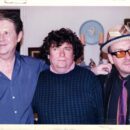1. Map the Song Form. Every song has its own structure, known as the song form or arrangement. This is based on the order and number of verses, pre-choruses, choruses, a possible “bridge” section and/or “tag ending.” I call this the map of the song. Type the lyrics and label each section so you can see the entire song arrangement. This gives you the outline and prediction needed to quickly learn it.
2. Establish the Best Key. Singers. You do not have just one correct key in which to sing all songs. A song melody has a lowest note and a highest note. Make sure that the melody note you start on permits you to sing the lowest and highest notes comfortably. Put your best foot forward and choose a key for which you can sing the entire melody range with ease while also sounding appropriate for the style and mood.
3. Learn the Melody. Don’t worry about memorizing the words just yet. If you are singing someone else’s song, put on a recording with the other vocalist singing it. Or, if you read music and have the sheet music, you can practice it that way. With this step you will isolate the melody and work on it until you have gained complete familiarity. There is a secret reason and wonderful result achieved when you practice the melody separately from the lyrics.
4. Learn the Lyrics. Learning the lyrics and understanding their meaning go hand in hand. Write or type out the lyrics. Define any words you don’t know in a dictionary. If you don’t understand the lyrics, you will not be able to deliver a believable message to the audience. Develop a personal interpretation of what you’re saying with them––which also helps you remember the order of the lyrics, verse to verse.
5. Map the Lyrics With Your Mouth. Learn them by saying, as well as singing, them repetitively with and without musical accompaniment. Do this as though you are singing with meaning to someone––the “live communication” mind-set really helps! It is much better than silent memorization.
6. Resolve Any Pitch or Range Difficulties. If you have chosen the right key for the song, any pitch difficulties and straining can come from mismanagement of the vowel and consonants of the word you are singing. Consonants can cause muscle tension in the tongue, which will adversely affect the functioning of your voice. Isolate what the vowel sound is (not vowel name, but vowel sound) for the notes and phrase or word giving you the problem.
Example: “life.” The vowel is “i” but the sound of it (in the context of a particular song) is a combination of “a” (apple) and “ah” (wand). To discover the vowel sound, say the word and sustain the vowel before you end the word. Listen to yourself. Find the vowel sound that is natural for you in the context of the word.
Next, sing the phrase. Discover what the vowel sound is for any word or syllable that is not totally on pitch or easy to sing. Let that be your focus as you again sing the phrase. A key to singing with ease and sounding pro is how you deal with vowels and maintaining consistency of pronunciation while not choking your voice with over-emphasized consonants.
7. Learn All Important Rhythmic and Musical Cues. Beginning to sing the lyrics at the incorrect time rhythmically is a sure sign of an amateur. For every phrase know how many beats you have to wait and on what beat you begin. Doing so will help you sing with confidence rather than standing on stage absorbed in worrying when to come in, while the audience wonders what you’re doing up there. With enough practice you will end up “feeling” your entrance and coming in on time. If not, you can always simply count the beats to come in correctly.
8. Lock Into the Rhythm. If you try to sing a melody note on a consonant, you’ll most likely arrive late rhythmically. The consonants are NOT your voice. Remember, your melody notes are created by the vowel sounds of your voice. Thinking the vowel sound as part of the melody note (not the consonant) will improve your rhythmic accuracy.
9. Develop Your Phrasing. A phrase is a group of words and notes. The group can be a complete or a partial sentence but a complete phrase is a complete thought. Phrases are often separated by a moment of silence (rests), even if a very short one. Phrasing is the way you rhythmicize the words in each sentence of your song. Your phrasing should have a similarity to the way you might speak the words to someone in a conversation. Style and phrasing are intimately entwined. This in turn, is intimately connected to your interpretation of the song.
10. Phrasing and Breathing. As a lead singer, the rule is: your breathing should not interrupt your phrasing. Or more to the point, each complete thought that you sing as expressed in words and melody should flow without a mechanical interruption such as taking a breath. There may be certain sections in a song where you hold a note longer or must sing several phrases in a row without pause. Prior to those sections, you would simply plan on taking a breath so you don’t interrupt the phrase.
11. Determine Dynamics. Music at its best is a universal language that can convey energy and emotion. Dynamics have to do with the volume variation of loud and soft. Staying at one volume without change can tend to make a song boring, emotionally monotone, less believable and so less communicative. Explore the emotions inherent in the music as well as the emotional variations within the lyrics. From there you can develop your sense of dynamics for each song you sing.
(This article is adapted from Jeannie Deva’s manuscript of her book for singers, which will be published in 2011 and contains all the things you need to know to achieve powerful and unforgettable performances.)
By Jeannie Deva
 miniBIO: Jeannie Deva is a celebrity voice and performance coach and recording studio vocal specialist with a list of impressive endorsements. Author of The Contemporary Vocalist book and CD series and The Deva Method Vocal Warm-ups and Cool-downs CD, her two private studios are located in Los Angeles and she teaches globally via webcam. See jeanniedeva.com and facebook.com/jeanniedeva.
miniBIO: Jeannie Deva is a celebrity voice and performance coach and recording studio vocal specialist with a list of impressive endorsements. Author of The Contemporary Vocalist book and CD series and The Deva Method Vocal Warm-ups and Cool-downs CD, her two private studios are located in Los Angeles and she teaches globally via webcam. See jeanniedeva.com and facebook.com/jeanniedeva.















